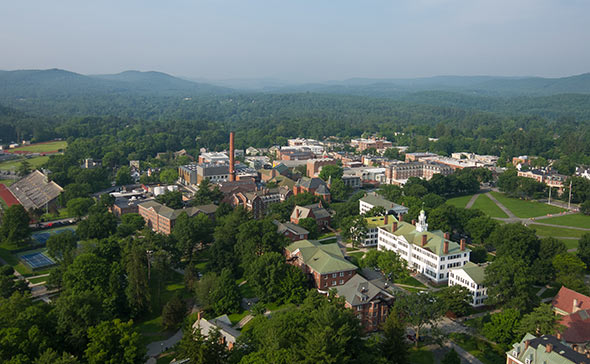
- About
- Departments & Services
- Projects
- Construction in Progress
- Service Requests
- News & Communications
Back to Top Nav
Back to Top Nav
Back to Top Nav
Dartmouth has joined local government and area businesses to help Hanover win recognition from the Environmental Protection Agency as a Green Power Community.

"The participation of Dartmouth, as the Upper Valley's largest power consumer, as well as our local business partners, made it possible for Hanover to become a Green Power Community," says Town Manager Julia Griffin. (Photo by Eli Burakian ’00)
Hanover is the first town in New Hampshire to earn the designation with the EPA program, which includes dozens of towns, cities, counties, and tribal governments across the United States. Green Power Communities are those that have shown that the local government, businesses, and residents collectively use green power in amounts that meet or exceed the EPA's green power purchase requirements.
"The participation of Dartmouth, as the Upper Valley's largest power consumer, as well as our local business partners, made it possible for Hanover to become a Green Power Community," says Town Manager Julia Griffin. "This shows how invested the Upper Valley is in renewable resources and energy efficiency, and this effort will move the Town of Hanover closer to its goal of becoming carbon neutral by 2030."
Read more
In 2014, the Hanover community’s annual green power usage, including all its partners, will be about 23 million kilowatt hours (kWh), or 17.2 percent of its baseload use. The EPA's minimum requirement, based on total annual energy use levels, is 5 percent for organizations using a total of 10 million to 100 million kWh a year, and 10 percent for organizations using a total of more than 1 million and up to 10 million kWh a year.
Dartmouth will use 10 percent green power, or 7.3 million kWh, in 2014, and has committed to a 10 percent green power usage level over the next five years, says Lisa Hogarty, vice president of campus planning and facilities.
All of the green power usage in the Hanover community partnership comes through green energy certificates purchased by the individual participants from Renewable Choice Energy of Boulder, Colo. The certificates offset power consumed from non-renewable power generators.
As an example of Dartmouth's continued investment in good environmental practices, Hogarty pointed to the energy efficiency building practices used in the construction of the Class of 1978 Life Sciences Center, which brought a Platinum LEED (Leadership in Energy and Environmental Design) certification from the U.S. Green Building Council.
"The College's commitment to sustainability, energy efficiency, and now this long-term agreement for green energy use, grows out of the belief that responsible environmental stewardship is part of our mission as a great liberal arts institution," Hogarty says.
The other participants in the Hanover Green Power Community project include the Co-op Food Store in Hanover, Dartmouth Printing Co., manufacturing firm Hypertherm Inc., and Kendal at Hanover. Hypertherm and Kendal are both covering 100 percent of their annual energy use with green power contracts.
In a statement, the EPA noted: "The Hanover, N.H., GPC is a great example of a Green Power Community that has full support from local businesses. While the town took the initiative in using green power, the business community quickly followed and pledged its support. As of June 2014, the Hanover GPC is using more than 23 million kWh of green power annually."